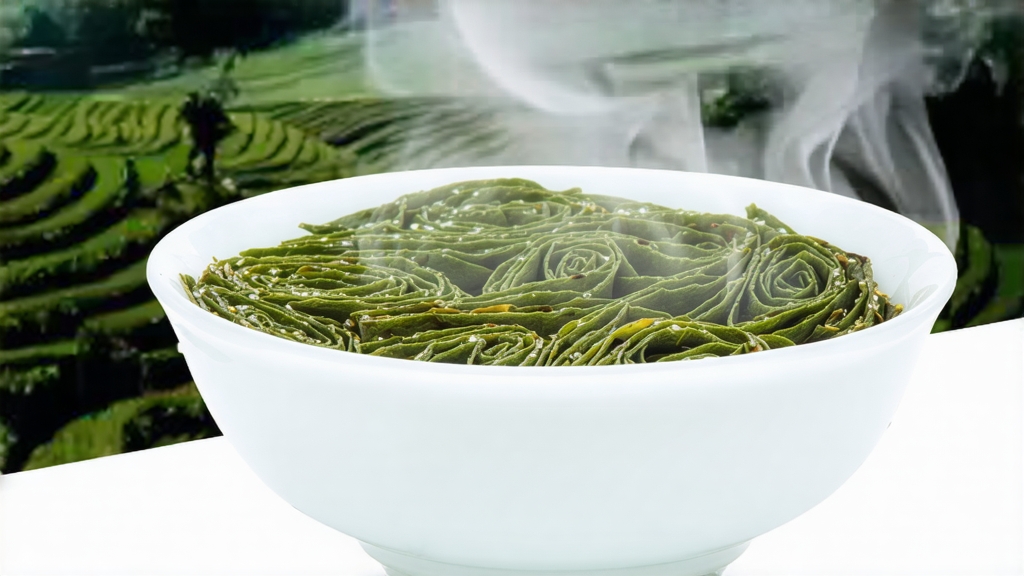
Rising like an emerald island above the Tropic of Cancer, Taiwan’s Alishan mountain range traps moist Pacific air into perpetual clouds. Between 1,000 and 1,400 metres, where daytime temperatures hover around 20 °C and nights drop to 12 °C, the Camellia sinensis var. sinensis bush slows its metabolism, thickening leaf cuticles and concentrating fragrant amino acids. The result is Alishan High-Mountain Oolong, a style that has re-defined “qing xiang” (light fragrance) oolong for the global market since the late 1970s.
History
Although Chinese immigrants brought tea seedlings to Taiwan in the 18th century, large-scale oolong production in Chiayi County’s Alishan region began only after the completion of the Alishan Forest Railway in 1912. Japanese colonial administrators promoted Assam black tea for export, yet small growers secretly kept Qingxin (a.k.a. TTES #12) cuttings in shaded ravines. When market demand shifted from black to partially oxidised tea in the 1970s, these high-altitude gardens—once considered too remote—became prized for their naturally sweet, low-tannin leaf. By 1985 Alishan Oolong had outpriced Tie Guan Yin at Taipei tea auctions, and today it commands premium shelves from Berlin to Berkeley.
Cultivar & Terroir
The dominant cultivar is Qingxin Oolong, a slow-growing, small-leaf bush that thrives on well-drained, slightly acidic laterite. At altitude, UV-B intensity increases 15 % for every 300 m, triggering higher catechin and L-theanine levels; the diurnal swing of 8–10 °C converts these compounds into floral lactones such as cis-jasmone and geraniol. Volatile analysis shows Alishan leaf contains 1.7 times the linalool of lowland Taiwanese oolong, explaining its signature orchid note. Gardens are typically south-east facing, allowing morning sun to evaporate dew while afternoon mist acts as a natural shade cloth.
Plucking Standard
Only the “xia kai ye” (summer opening leaf) is picked—three, occasionally four, mature leaves including the bud. Pickers wear hemp backpacks to prevent bruising, and leaf is carried downhill within two hours to preserve cellular turgor. A 25 kg harvest yields roughly 5 kg of finished tea, reflecting the low moisture content at altitude.
Crafting the Leaf
- Solar Withering: Leaves are spread 3 cm thick on bamboo trays under filtered morning sun for 20–30 min, reducing moisture to 70 %.
- Indoor Withering: Trays rest on slatted racks in a climate-controlled room (23 °C, 65 % RH) for 6–8 h, with gentle tumbling every hour to edge-oxidise the leaf.
- Shaking & Oxidation: In cloth-lined barrels the leaf is tossed with a wrist-flick motion 5–7 times over 4 h, bruising epidermal cells just enough to initiate 20–25 % oxidation—half that of Dong Ding oolong.
- Fixation: A 260 °C drum roaster halts oxidation in 3 min, locking in a jade-green centre ringed by toasted amber.
- Rolling: The warm leaf is wrapped in cotton cloth and compressed into a ball, then rolled 60 times on a mechanical plate to twist cells and release sap. This step is repeated 30–35 cycles, forming the tight hemispherical “dragon ball” shape.
- Drying: A 90 °C conveyor oven reduces moisture to 3 %, followed by a 60 °C “recycling bake” for 40 min to enhance shelf stability.
- Fluffing & Sorting: Tea is rested 48 h, then passed over a 12-mesh sieve to remove stems and flake, ensuring uniform 8-mm pellets.
Roasting Spectrum
Modern Alishan is sold on a roast gradient:
- “Light清香” (0–1 h charcoal, 80 °C) preserves alpine florals.
- “Medium 中焙” (3 h, 100 °C) adds honeyed squash notes.
- “Traditional 傳統焙” (6 h + 3-month aging) yields cocoa and roasted chestnut, favoured by older drinkers.
Brewing Parameters
Water: 95 °C soft water